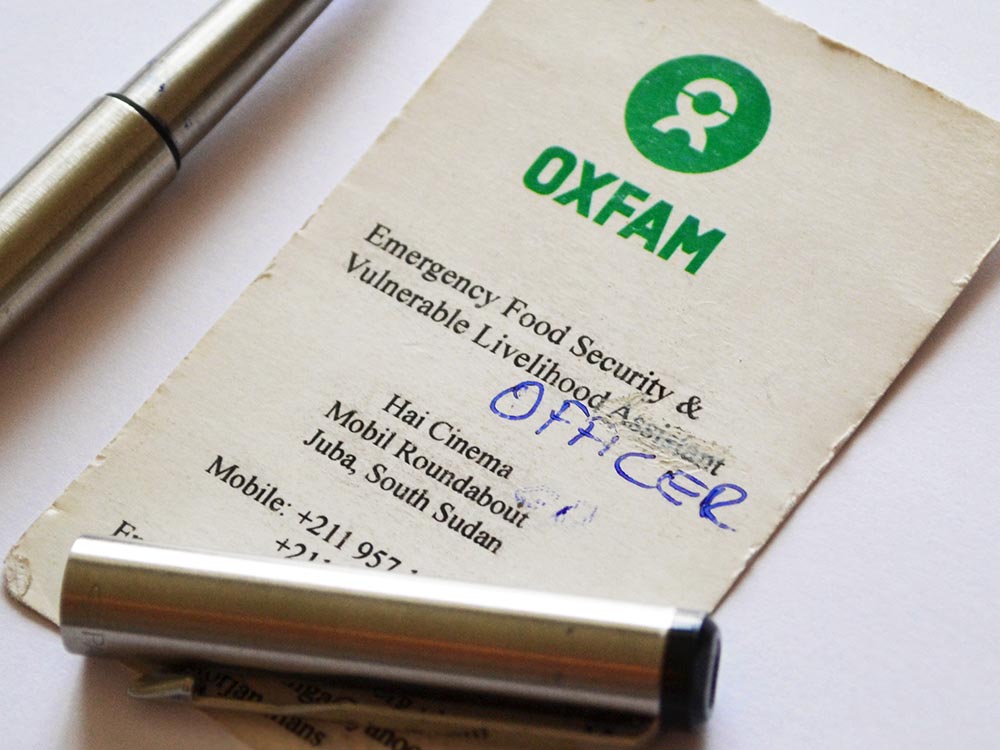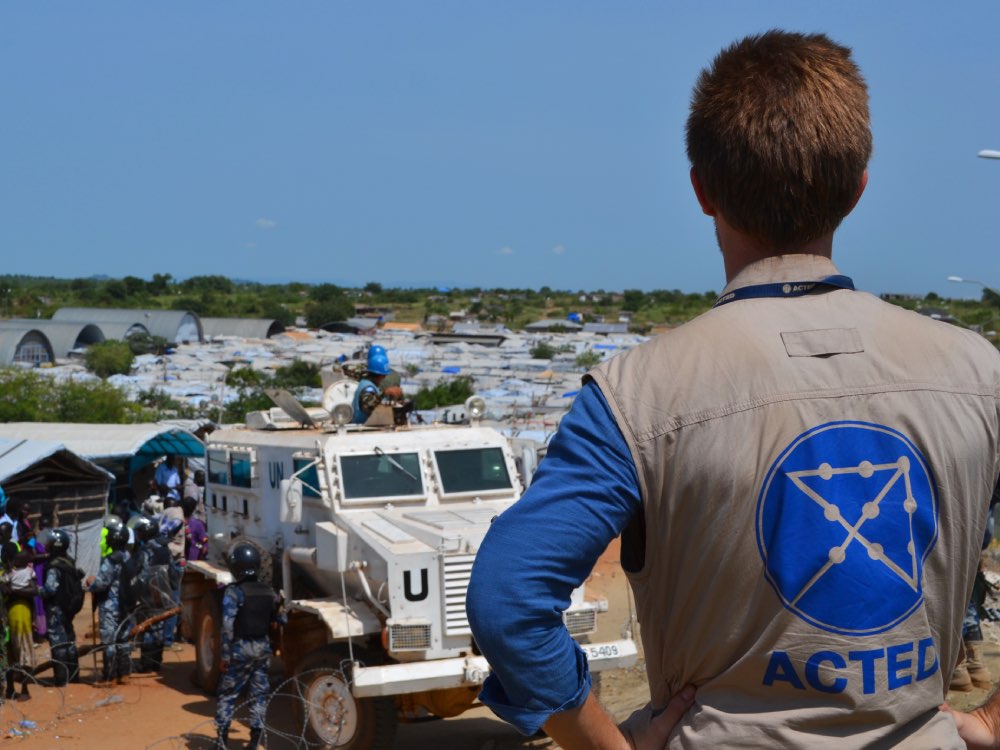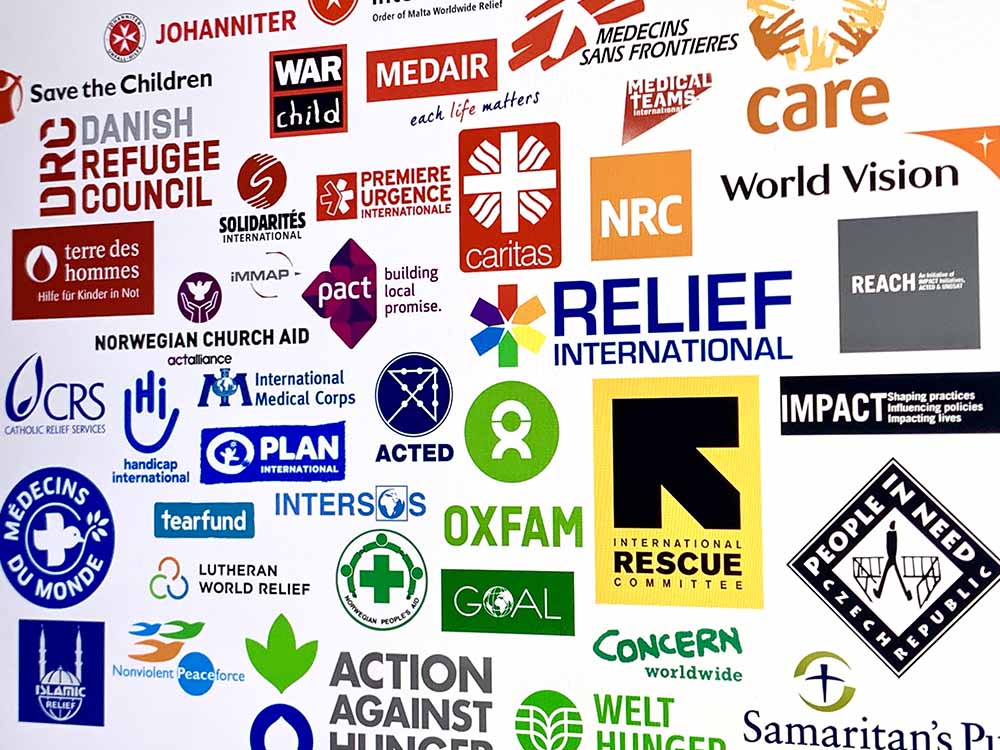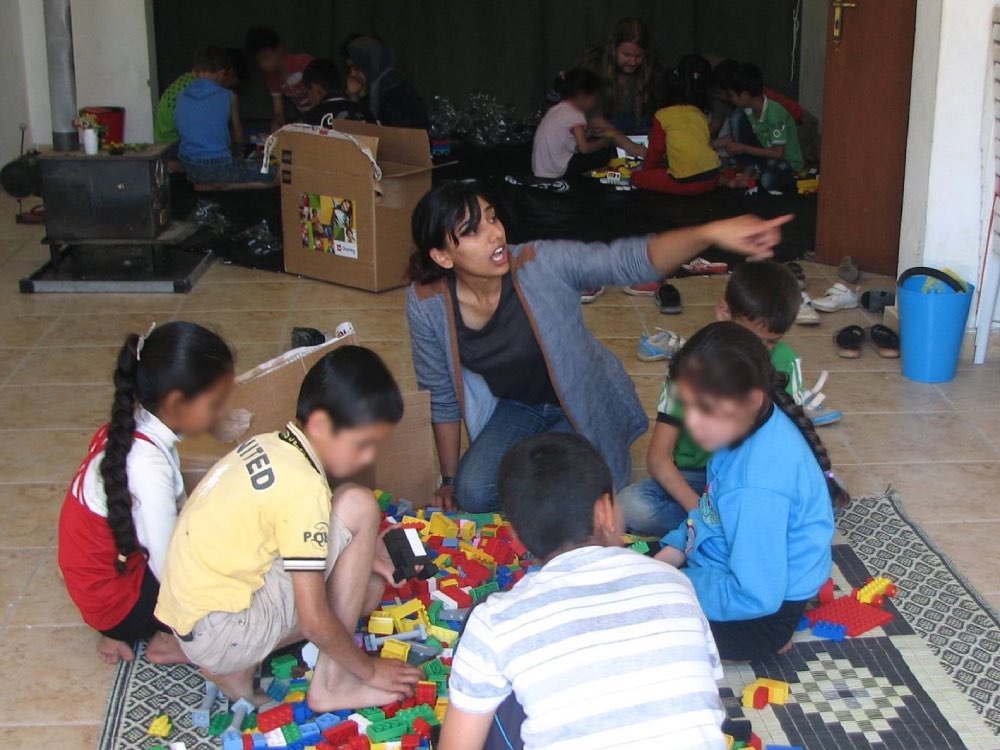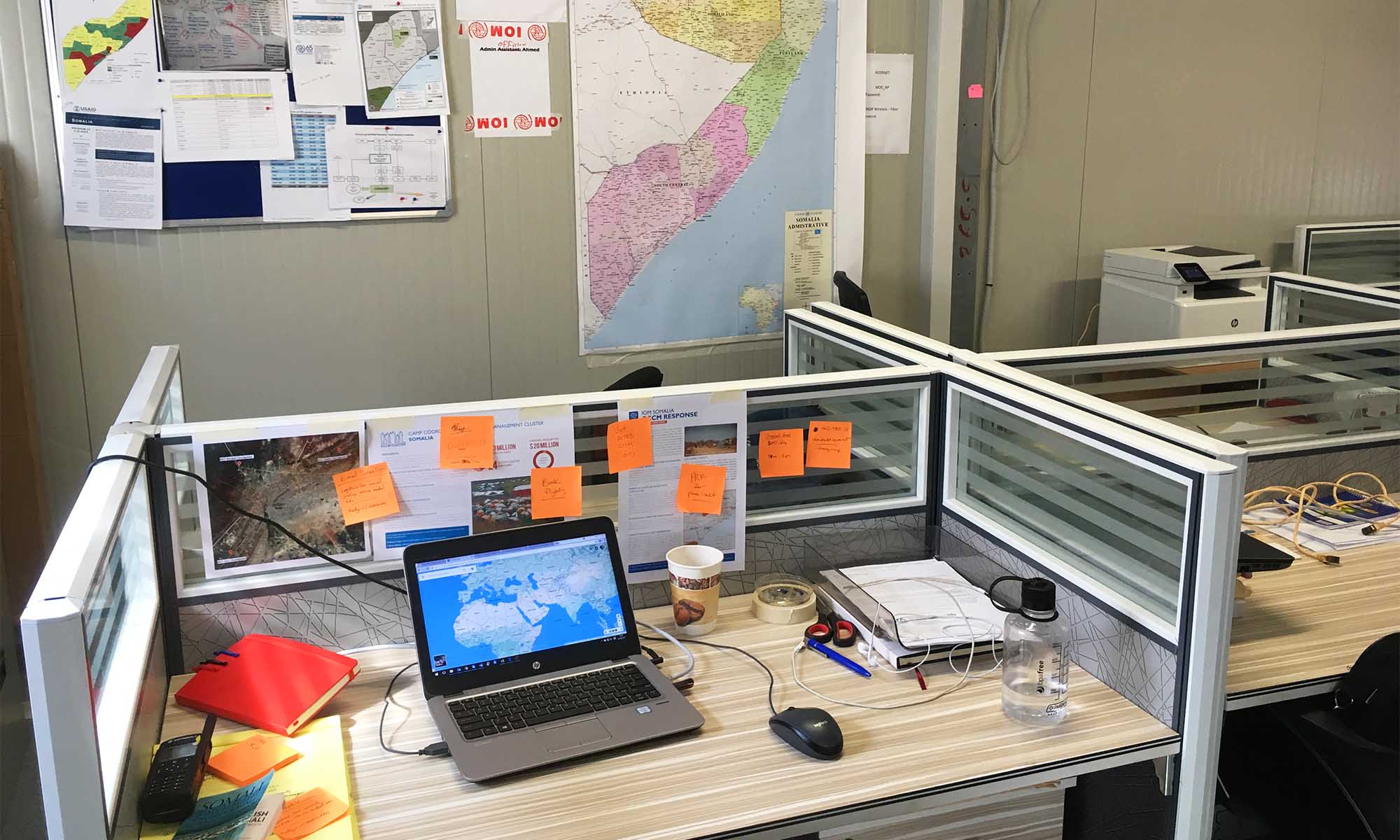
Welcome to the field. Here's your desk.
Even in the field, aid work often means office work. We take a photo tour of field offices and reveal what humanitarians do at their desks.
It was my first day as a humanitarian. When my flight landed in steamy Juba, I already knew that the situation in South Sudan was dire. In the six months before I arrived, there had been massacres in the capital city, hundreds of thousands had fled into UN-protected camps across the country, and real famine was looming. Even the airport was tense, crawling with soldiers and more guns than I had ever seen before in my life.
As a freshly-minted aid worker, I was poised to spring into action.
But instead of heading to the front lines or into a waiting helicopter, I was picked up by a dusty white Land Cruiser and driven straight to… The office.
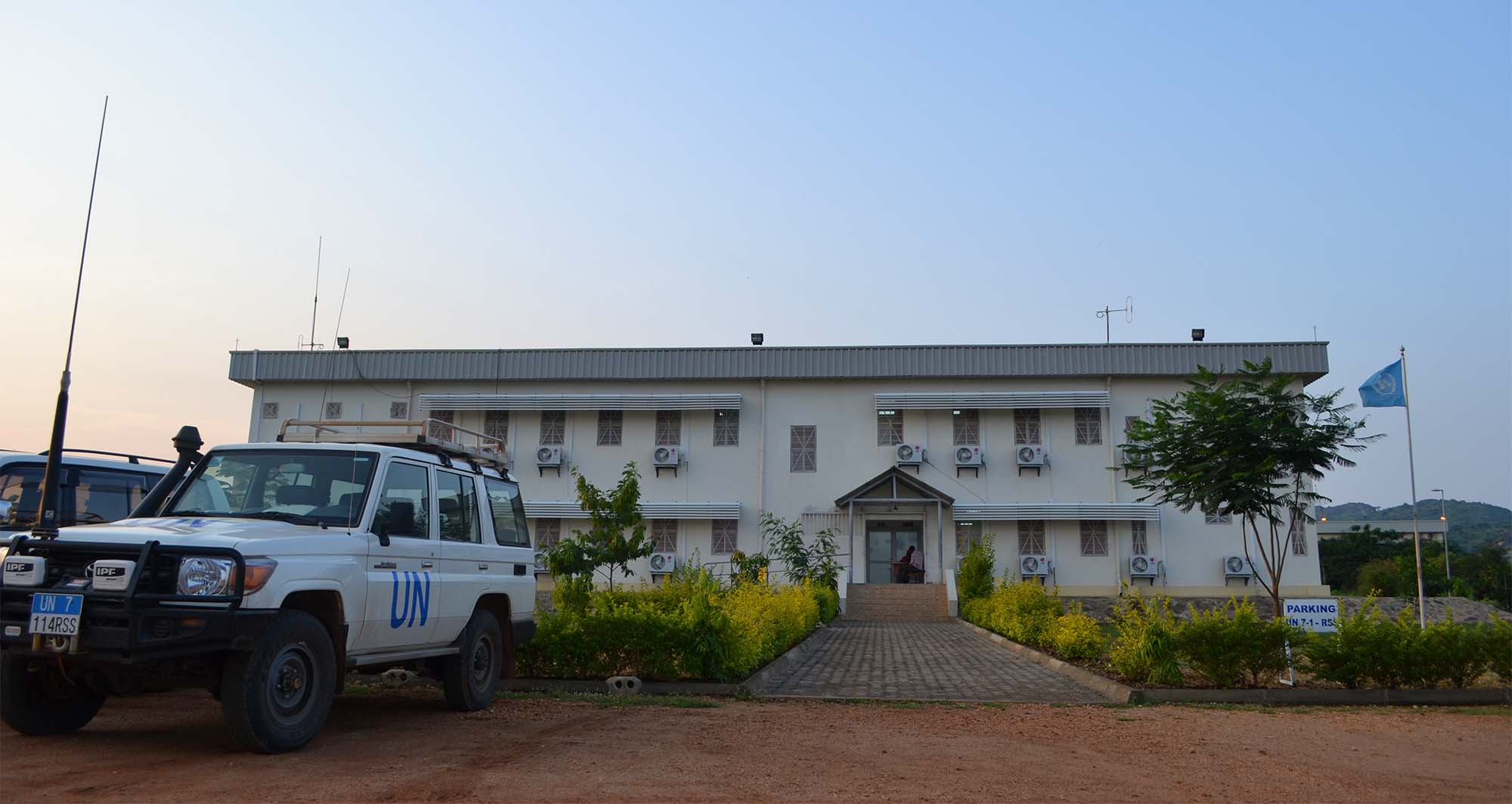
I was expecting to find a place of work buzzing with hurried activity, a tempo of long hours and late nights, doing everything we could to fix the situation. War had just broken out, after all, and our mandate was to save lives.
Instead, what I found was a very comfortable two storey office, purring with air conditioners and florescent lights. My well-dressed colleagues strolled the halls and shared laughs by the water cooler. My only assignment on that first day was to settle into my desk and wait for my email to be activated.
At 4:55pm, the place finally came alive with a sense of urgency. My humanitarian colleagues sprang into action as never before, slamming shut their laptops and scrambling down the hallways towards the door. Nobody wanted to miss the convoy of Land Cruisers heading back to the city centre where their hotel rooms and guesthouses awaited.
So went my baptism into aid worker office life.
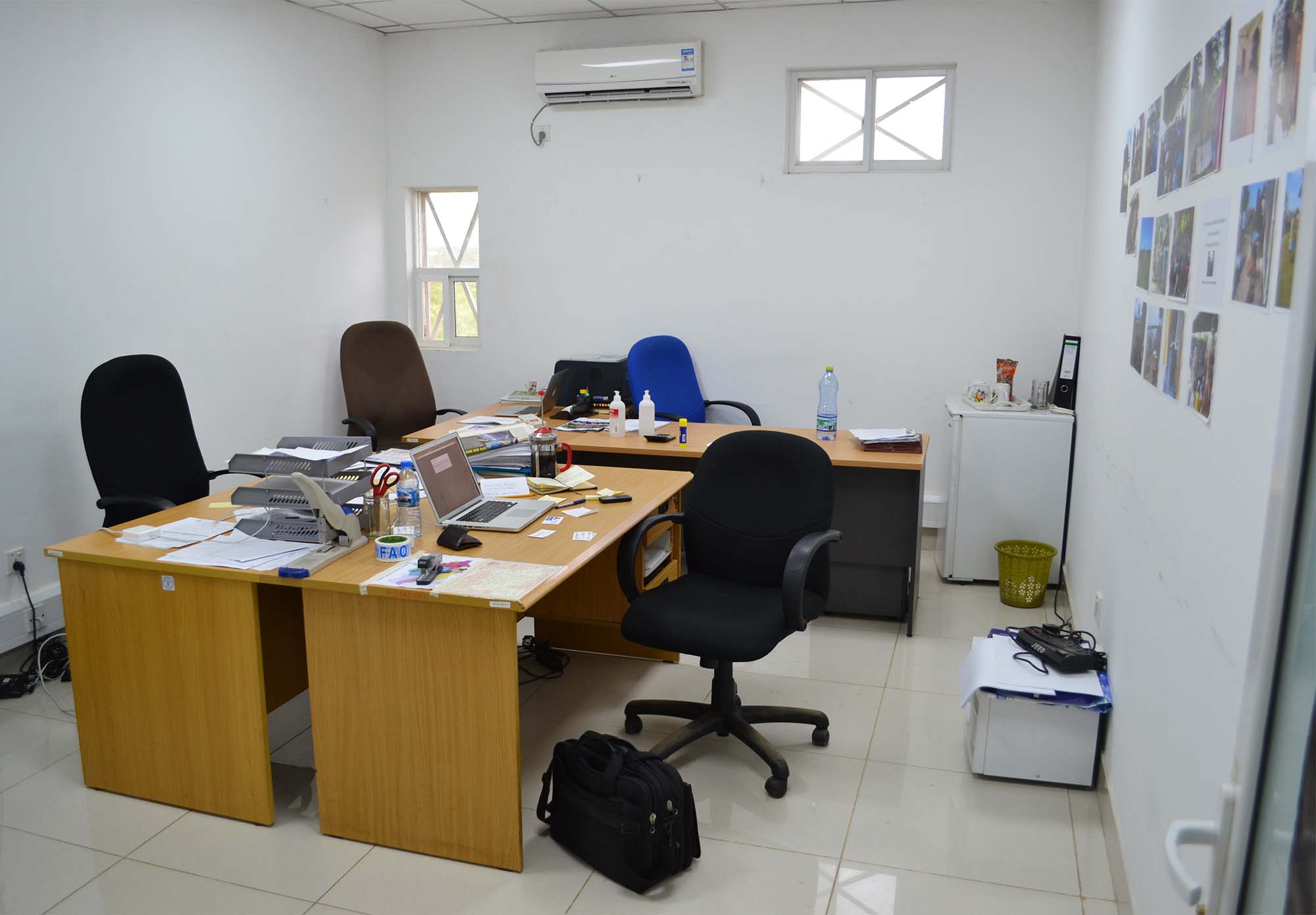
Types of offices
Before we dive in, let’s get our terminology straight. Not all humanitarian offices are field offices. An aid agency’s headquarters is not a field office, nor are their regional bureaus — usually scattered around the world in Buenos Aires or Panama City, Amman or Cairo, Dakar or Nairobi, Bangkok or Kuala Lumpur.
These are different from field offices because they don’t directly implement any humanitarian projects. Instead, they provide support to the field offices. This can take the form of fundraising, building relationships with donors and partner organisations, or dispensing technical expertise (although some might say that the “support” provided by HQ and regional offices is better defined as “creating additional layers of bureaucracy”).

So, what is a field office? The term is ambiguous, but it usually refers to an office in a country where there are ongoing humanitarian aid operations. An organisation will have multiple field offices in a country, with one designated as the main “country office” and other smaller ones called “sub-offices”. Let’s allow one NGO to describe their constellation of field offices in Afghanistan in their own words:
“HI has five offices located in the different provinces of intervention. The country office is in the capital city (Kabul) and hosts the management team, including operations, finance, logistics, human resources, technical unit, humanitarian access and advocacy, and security. Four sub-offices, located in Herat (west), Kunduz (north), Nimroz, and Kandahar (south), are fully operational with dedicated support services and project management teams.”
This classic arrangement is mimicked by nearly every international NGO and UN agency in the aid sector.
What is "office work" in the field?
“I want to go to the field,” you’ve probably told yourself, “because I can’t imagine sitting behind a desk all day.”
And then, suddenly, there you are: a newly hired aid worker near the battlefields of Ukraine, in the baking heat of the Sahel, or nestled into a snow-clad valley of the Hindu Kush — sitting in an office. That’s the point of this article. It’s a public service announcement to aspiring aid workers: Attention! A great deal of humanitarian field work is, in fact, office work.
But why is that? Shouldn’t aid workers be outside under the sun, distributing food, water, and medicine?
It’s important to understand that turning the colossal wheels of the international aid bureaucracy generates a massive amount of two things: paperwork and meetings. There are project proposals, budget forecasts, quarterly reports, narrative reports, financial reports, assessment reports, mid-term evaluations, no-cost extensions, procurement request forms, vendor contracts, bills of quantity, memorandums of understanding, beneficiary lists, distribution lists, movement request forms, travel expense claims, and — big inhale — team meetings, coordination meetings, community leadership meetings, youth committee meetings, donor meetings, government meetings, country security meetings, working group meetings, cluster meetings, and of course, sub-cluster meetings.
And I didn’t even mention emails.
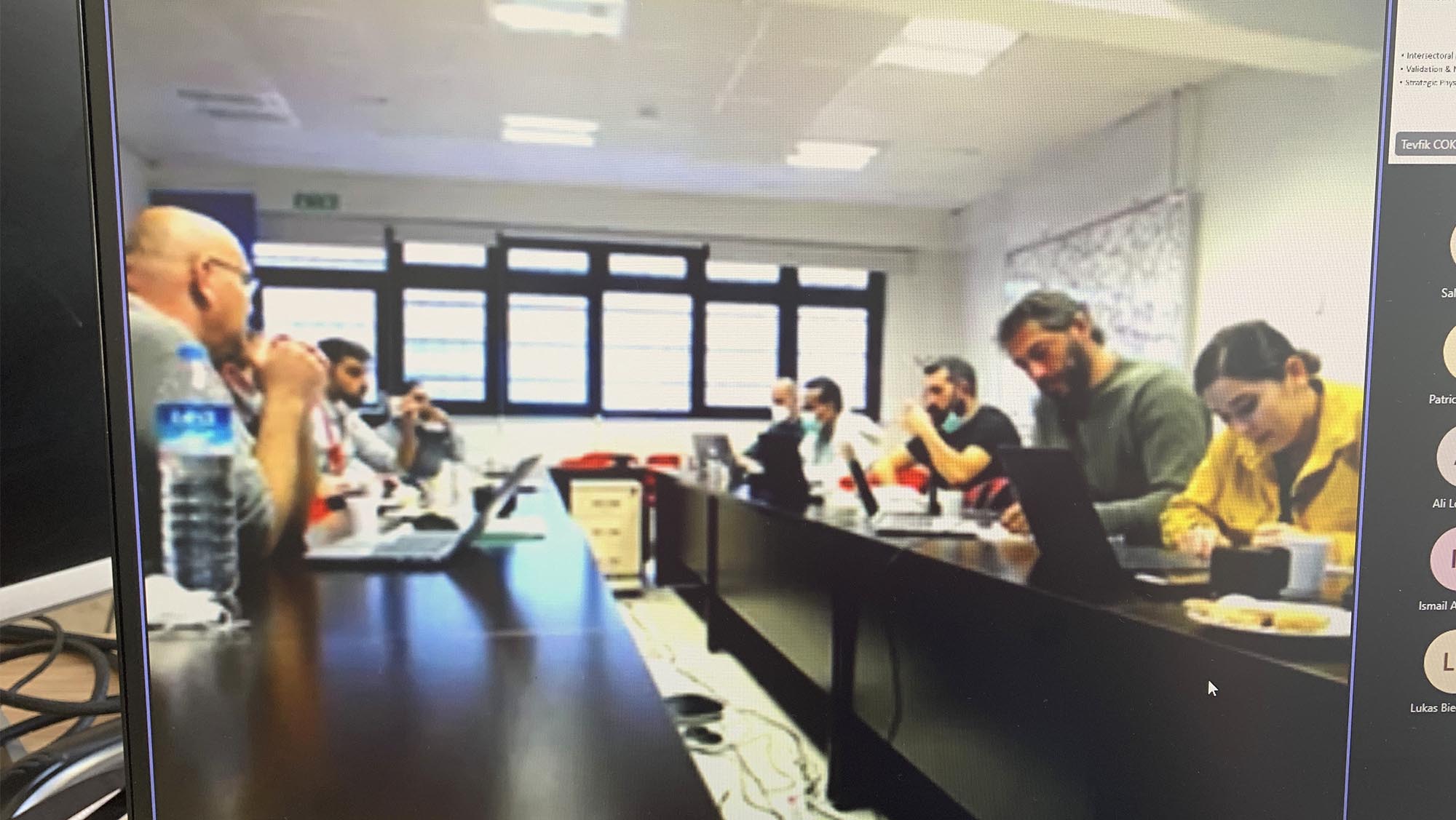
The good news is that, while office work will follow you throughout your humanitarian career, there is less of it the further you go into the field. There are always tasks to be done in front of a computer, but it’s never one hundred percent of anyone’s job in the field. Moreover, the office duties that you do have are clearly linked to ongoing relief operations and helping people in need.
As an illustration, let’s take a look at a page from my to-do list when I was managing IDP camps with the UN in Somalia:
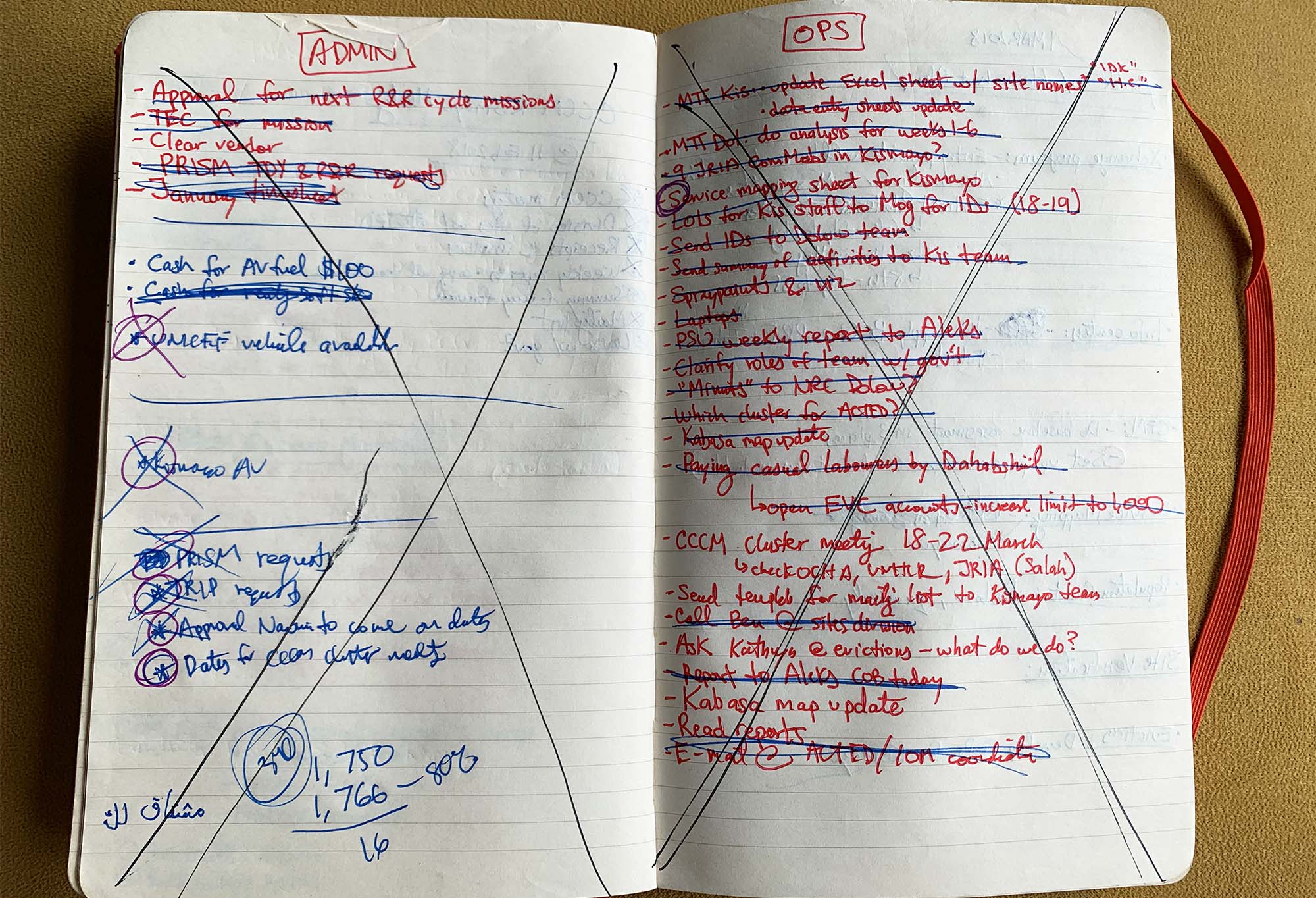
We can see that, even in the relatively deep field, there was a mix of office-related tasks to be done.
On the admin side, I had to get approval for my next R&R, fill out my timesheet, complete a reimbursement form for my previous field mission, and request an armoured vehicle (and cash to pay for its fuel) for an upcoming field mission.
On the operations side, my tasks were a wildly miscellaneous bunch, including updating an Excel sheet of IDP camps, doing an analysis of displaced families entering and leaving the camps, buying laptops for six newly-hired field staff and clarifying their job roles, updating a map, paying the labourers who completed a small construction project, planning next week’s cluster meeting (which I would chair), drafting official travel letters so that field teams could fly to Mogadishu, reading weekly reports from field teams, calling this person, emailing that government ministry, and finally, purchasing spraypaint.
It’s a mountain of office work, but the difference — compared to the office work you would do in HQ or a regional office — is that its effects are immediately felt. You don’t complete that form? You don’t get on the airplane next week. You forget to send that email to the local government? The cash distribution gets cancelled. You don’t pay the workmen who constructed the new latrines? They show up outside your office to protest.
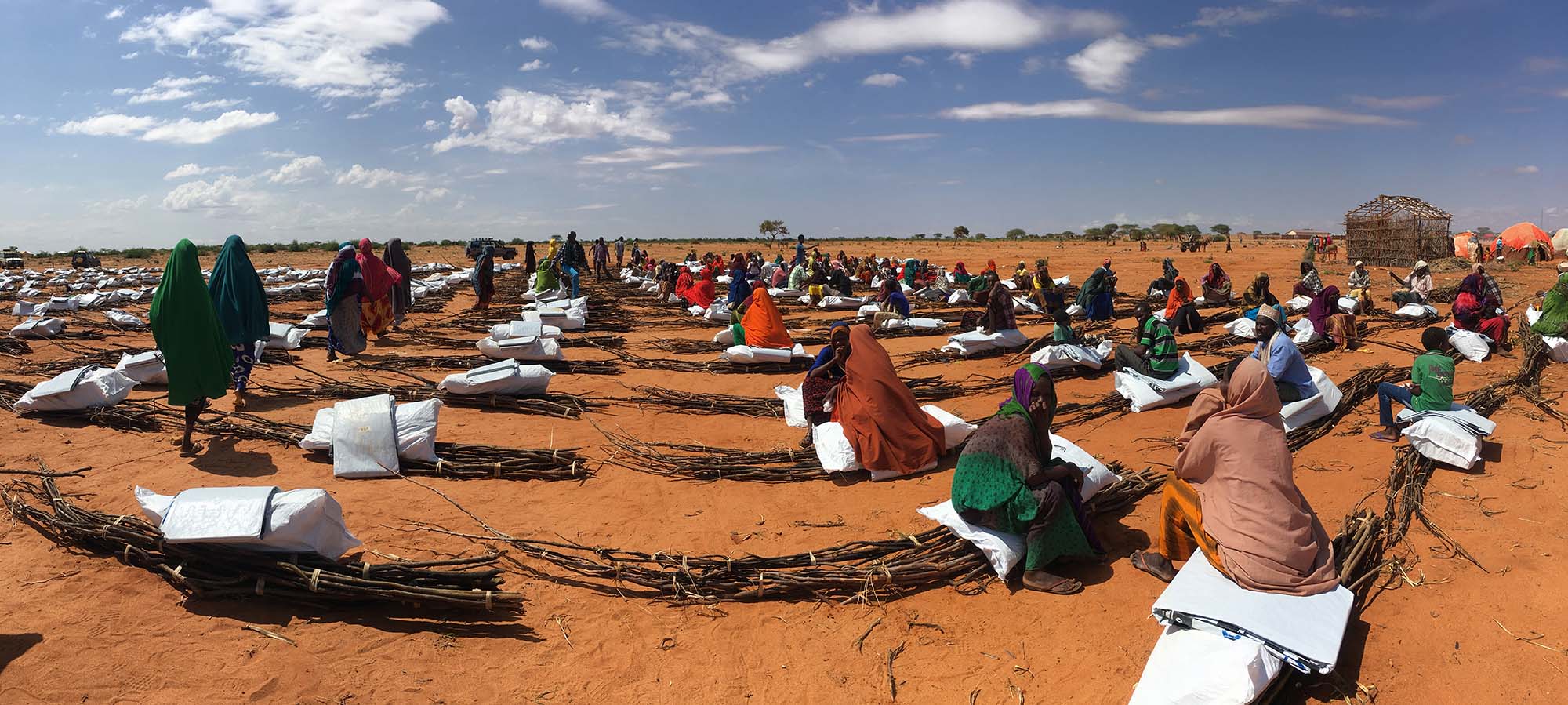
Of course, the type of office work you do — and the ratio of office-work-to-outside-work — will vary according to your job. Junior staff responsible for producing project proposals and reports will spend plenty of time on their laptops, as will those working in finance, procurement, or logistics. Project managers and technical coordinators will pass many hours on calls and in meetings. But everyone who is based in the field, especially at the sub-office level, will spend some amount of time each week — and usually every day — outside interacting with the community they are serving.
Peek inside the mystery box: A photo tour of field offices
For many career paths, it’s possible to have a mental image of what your future office might look like before accepting a job offer. This is thanks to your personal experiences (from waiting in the doctor’s office or headmaster’s office, to visiting your father’s corporate cubicle as a child) and thanks to what you’ve seen in films and television (law firms in Suits, advertising agencies in Mad Men, newspaper bureaus in Spotlight or Shattered Glass, and even government intelligence agencies in Zero Dark Thirty or Bridge of Spies, and many more).
But if you’re an aspiring aid worker, the field office that awaits you is a black hole, a mystery box. You just have to trust that the hiring manager on the other end of the low-bandwidth Zoom call in Jalalabad isn’t delusional when she reassures you that the office is “quite nice actually”.
So, let’s open the mystery box. Join us on a photo tour of thirteen humanitarian field offices — country offices and sub-offices — from NGOs and UN agencies across Africa, Asia, and the Middle East.
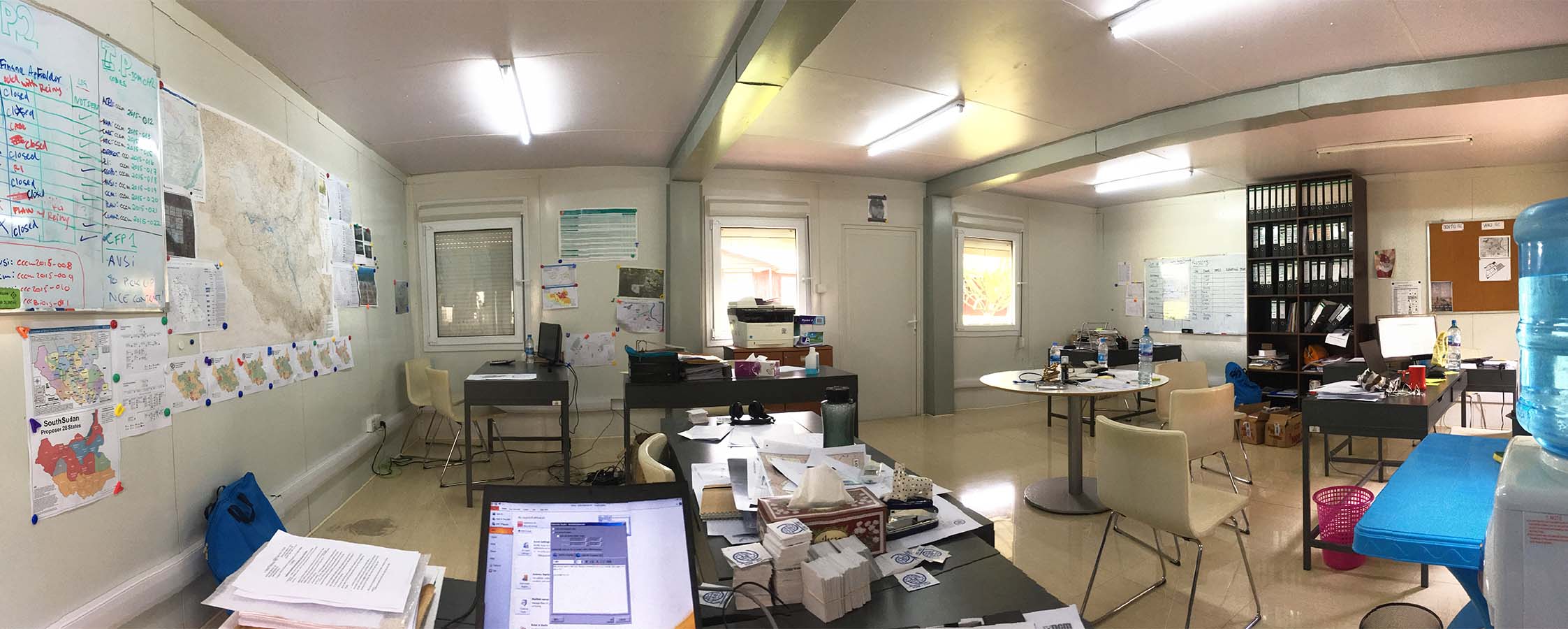
Location: Juba, South Sudan
Type: Country office
Organisation: United Nations
Office highlights: We began this article in Juba, so let’s start our tour there too. This is just one room of a sprawling UN country office. The structures were made from pre-fab containers, so the floors creaked and the walls were thin. But the rooms were pumped full of air conditioning and the electricity rarely cut out, thanks to multiple backup generators. Tellingly, colleagues here dressed for the office rather than for days outside in the sun or rain. This is a specimen from the comfier end of the field office spectrum.
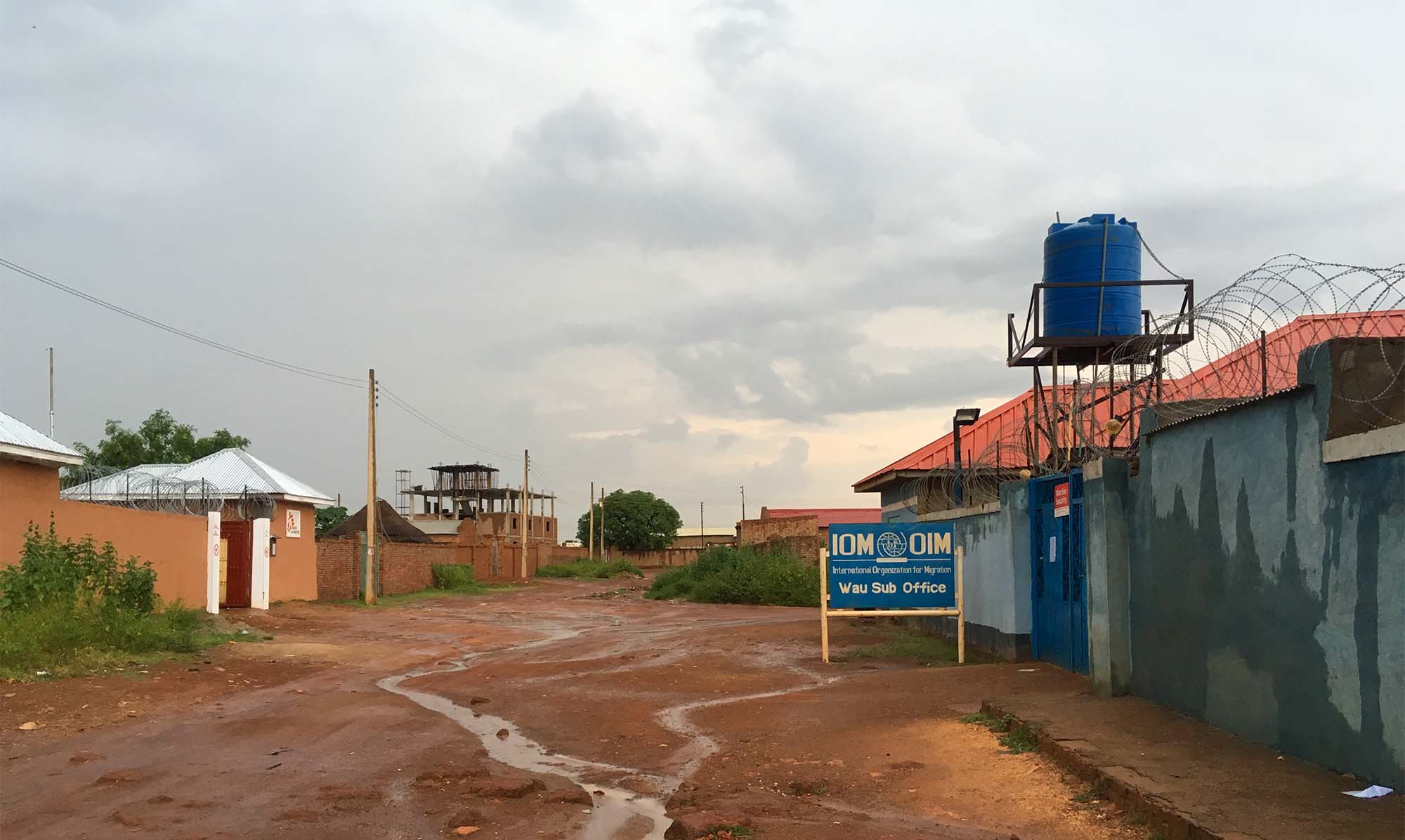
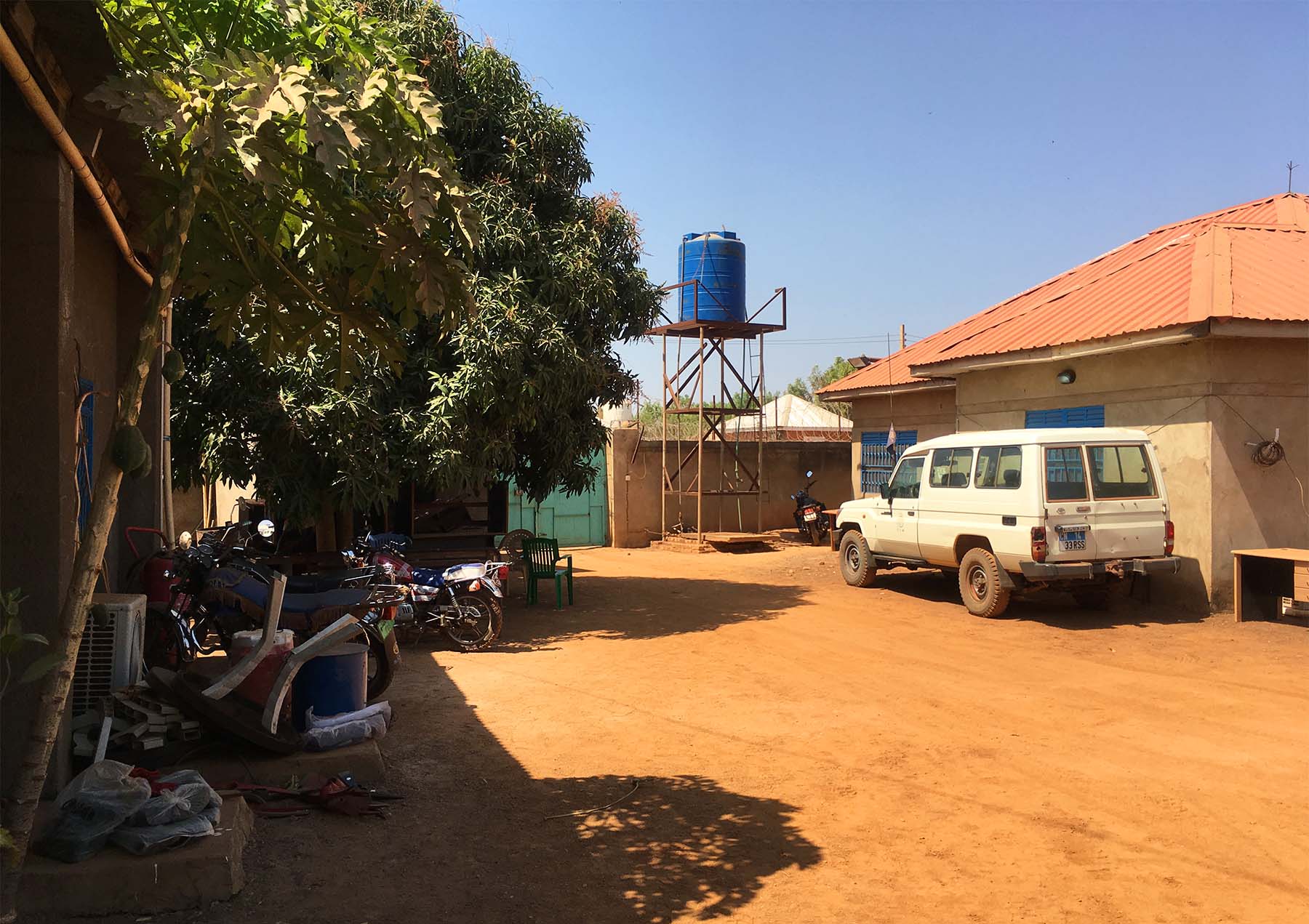
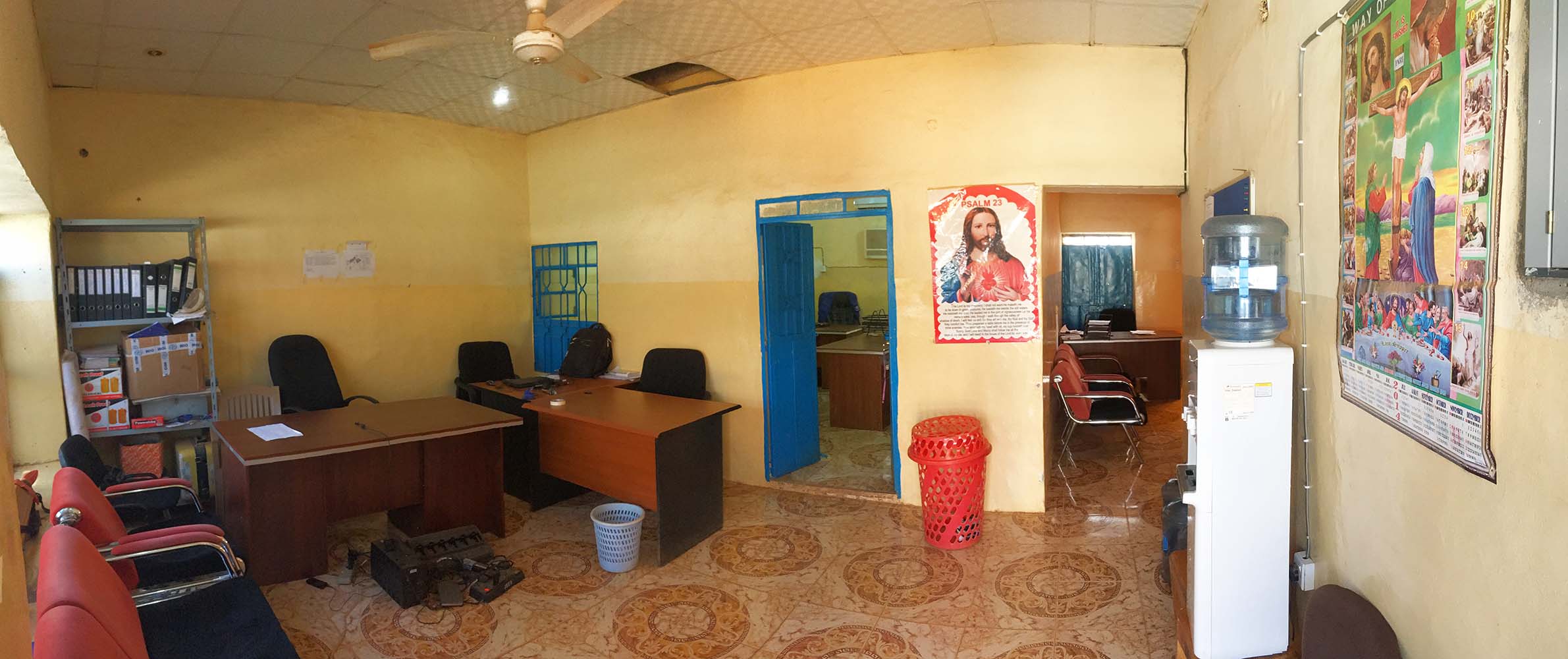
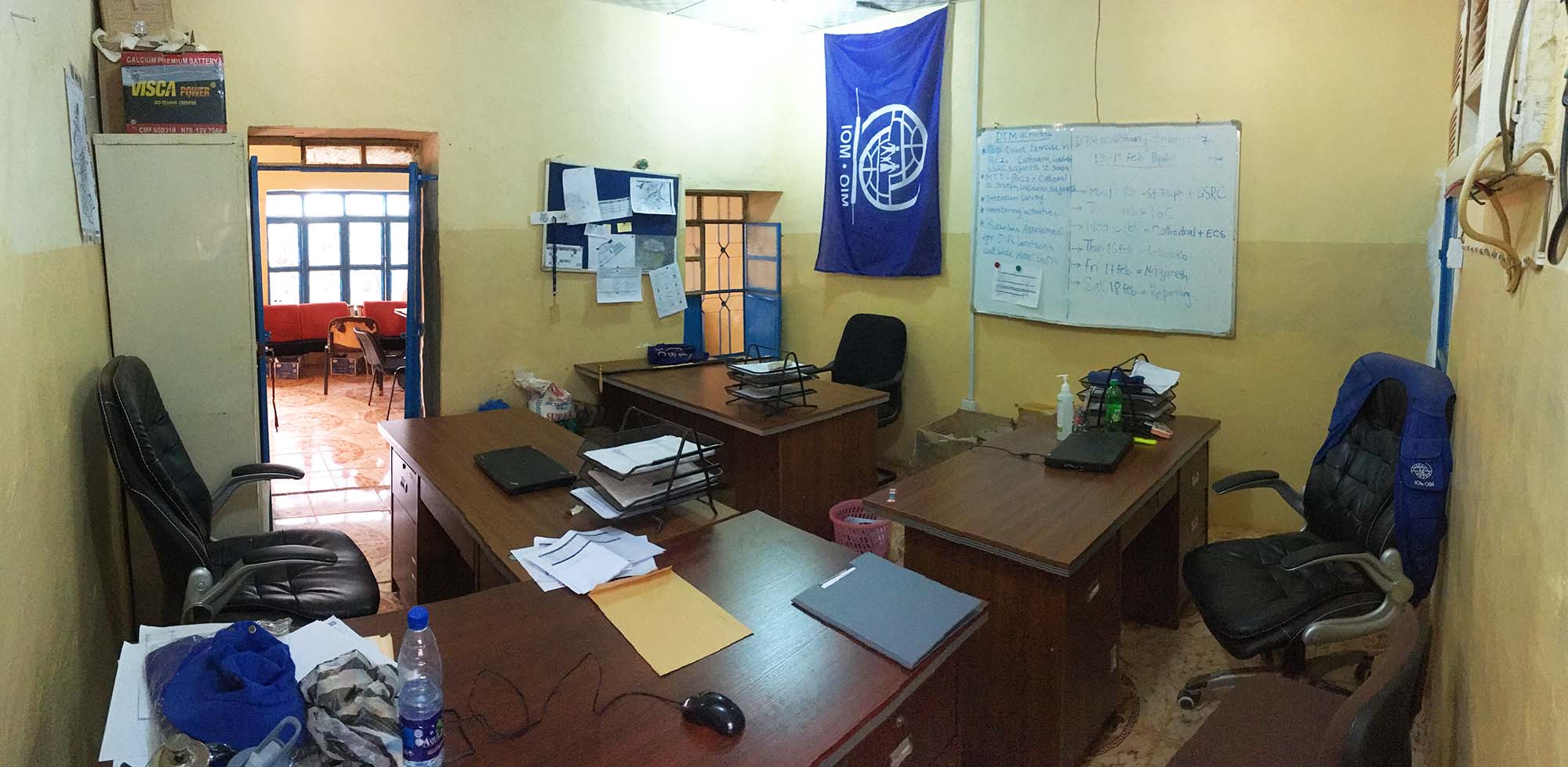
Location: Wau, South Sudan
Type: Sub-office
Organisation: United Nations
Office highlights: Next, we travel to a sub-office of the same UN agency in the same country. As you can see, the physical environment is a downgrade compared to the cushy country office in the capital. Electrical power was not reliable, there was no air conditioning, and the toilet was an outdoor latrine. But the esprit de corps among colleagues was strong, and this was a motivating place to come to work each morning. In fact, my colleagues and I only worked a portion of each day inside this office, and the rest was spent inside the nearby IDP camp.

Location: Aweil, South Sudan
Type: Sub-office
Organisation: NGO
Office highlights: Rather than installing a full-service espresso bar with a professional barista, this small NGO sub-office adopted a different — but quite common in the aid sector — approach for providing their hard-working employees with free hot beverages: a can of instant coffee and a box of powdered milk up on a shelf. Other perks included functioning WiFi and 40ºC indoor temperatures.

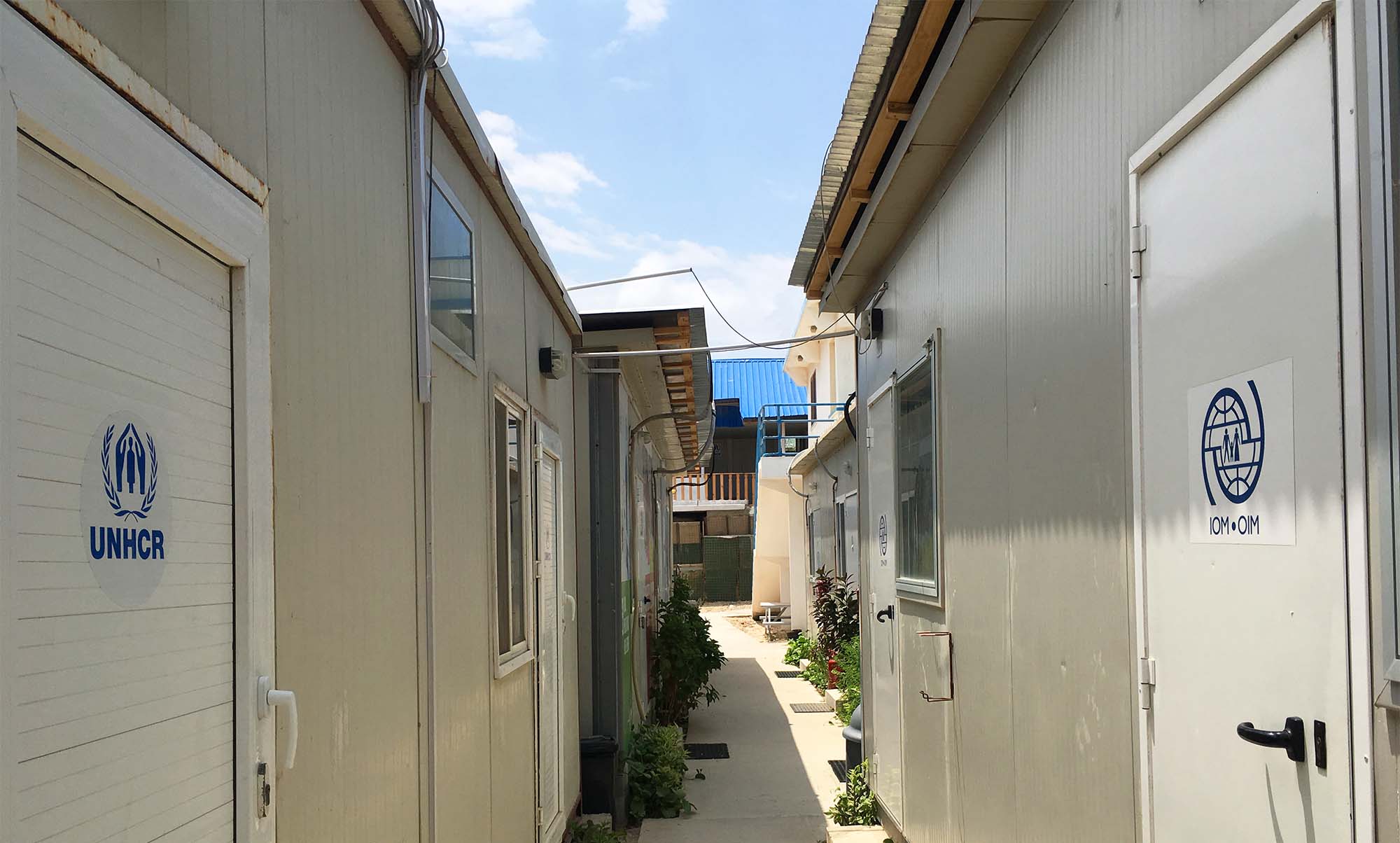
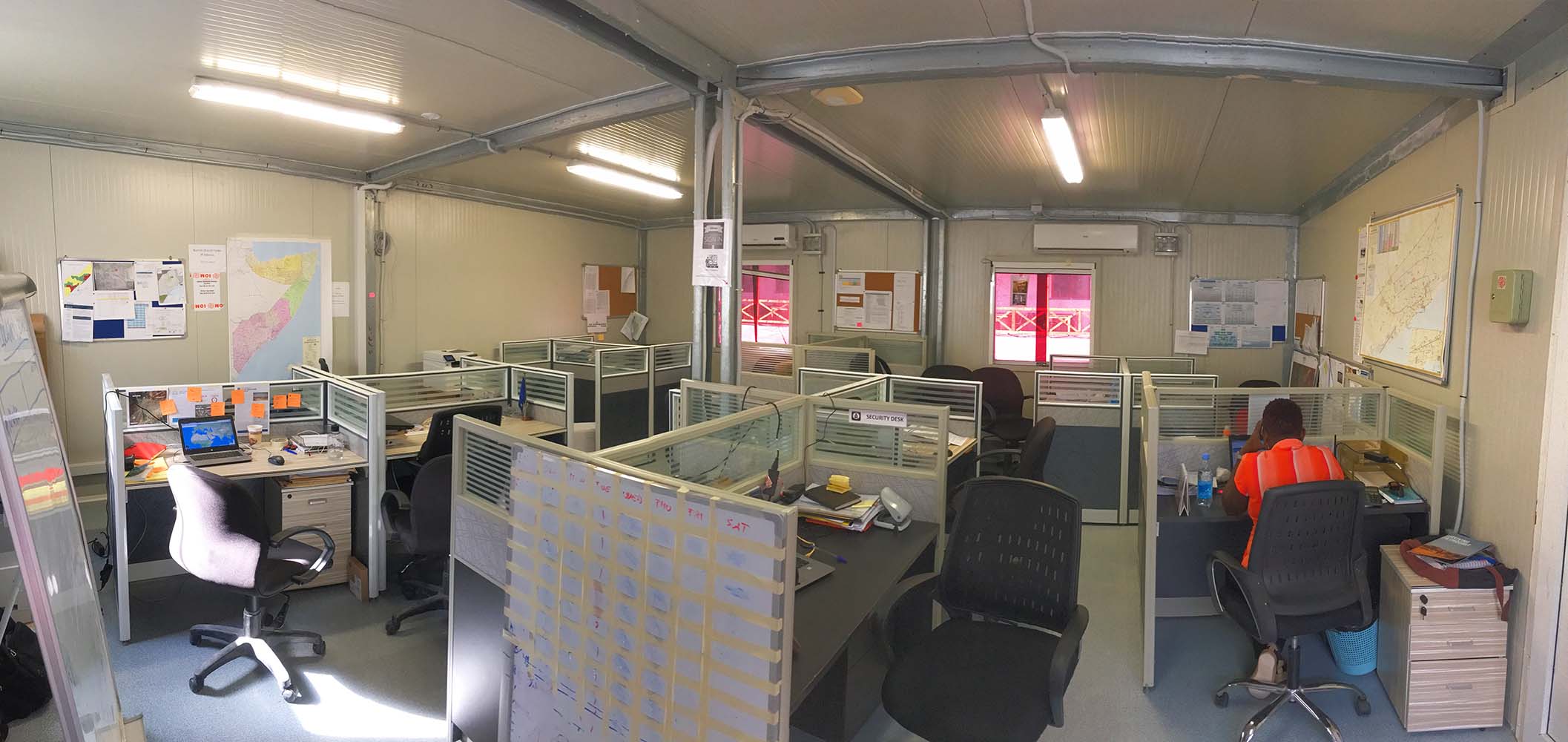
Location: Mogadishu, Somalia
Type: Country office
Organisation: United Nations
Office highlights: This single room was the entire country office for a UN agency in Somalia at the time (ignoring, as we should, all the team members working from the Nairobi office across the border in Kenya). The sixteen mini cubicles were “hot desks“, meaning if you arrived too late after 08:00, you wouldn’t be able to reclaim your seat from yesterday. As you can imagine, when two or three people were on different phone calls at the same time — especially one particular Procurement Officer fond of yelling at delinquent suppliers, god bless him — the noise level became intolerable.
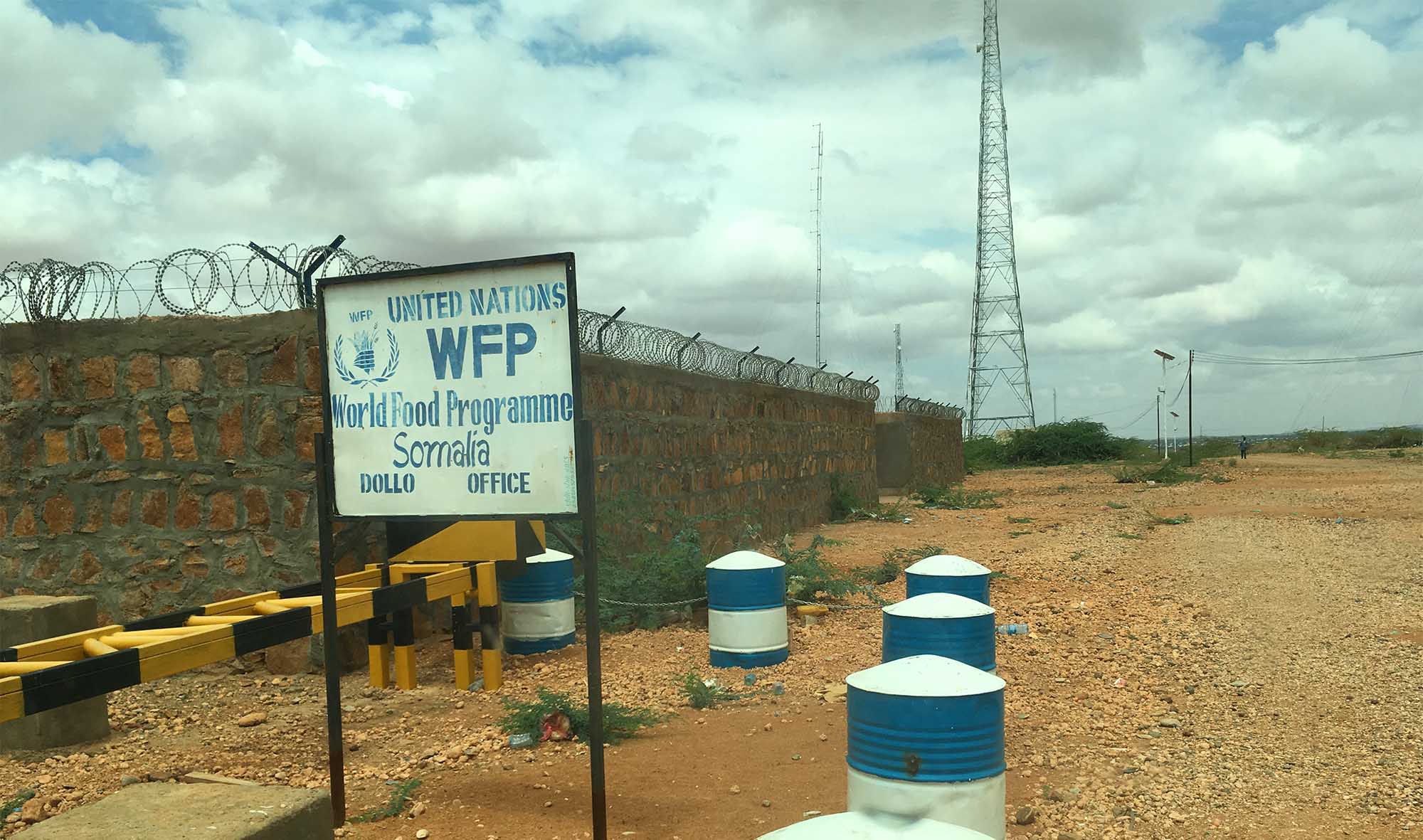


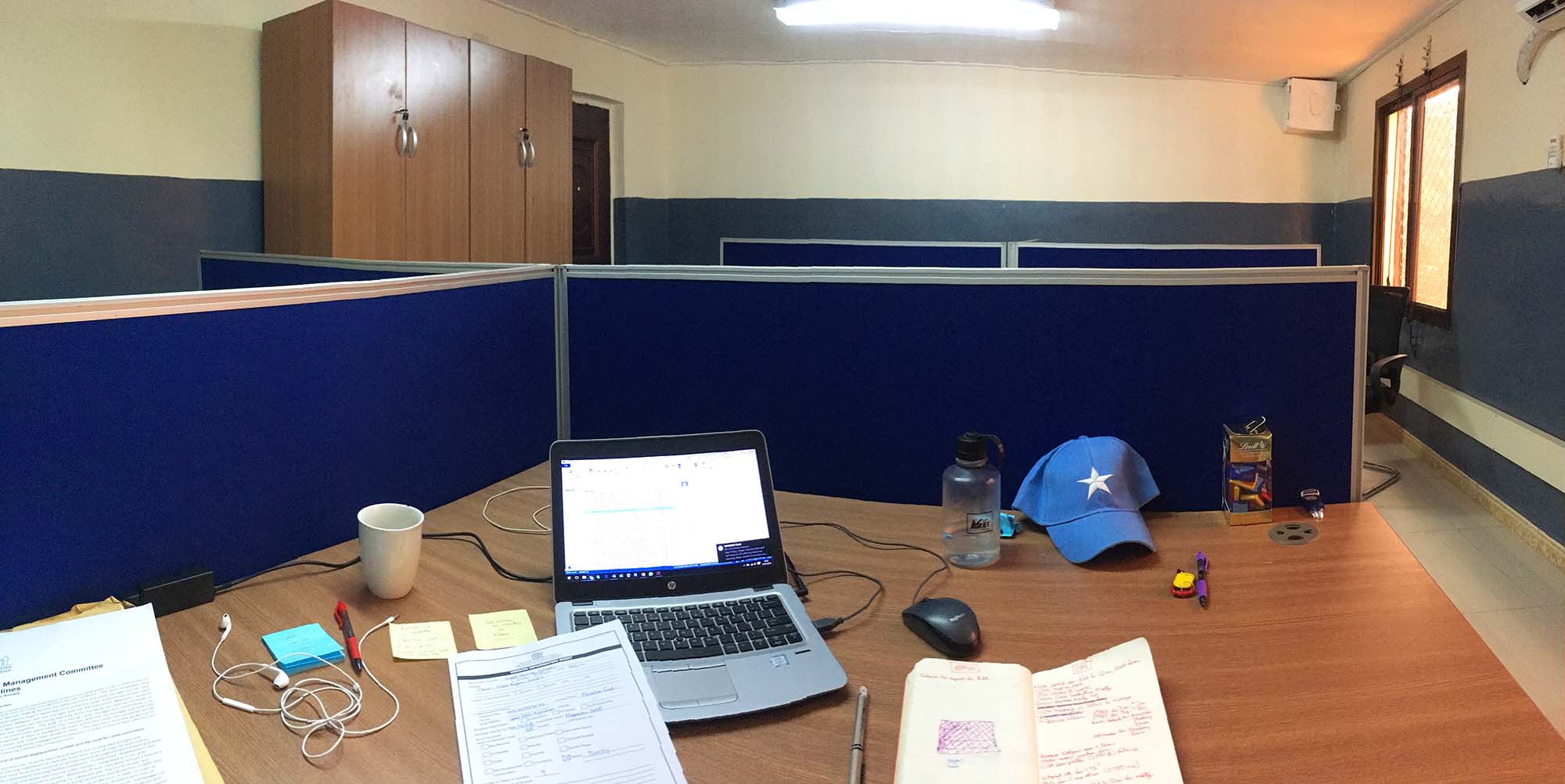
Location: Dolow, Somalia
Type: Sub-office
Organisation: United Nations
Office highlights: Far out in the Somali desert, an actual stone’s throw from the Ethiopian border, is this UN outpost. It was possibly the loneliest place I’ve ever lived and worked. On some weekends, the only staff who remained behind — while the rest escaped to the bright lights of Mogadishu or Nairobi — were myself and one or two others. The workweek was better: I would spend 4-5 hours each day in the nearby camps working with my team and the IDP community members, which was always fulfilling. But the office hours afterwards were filled with long stretches of silence, punctuated only by mouse clicks and keyboard clacks.
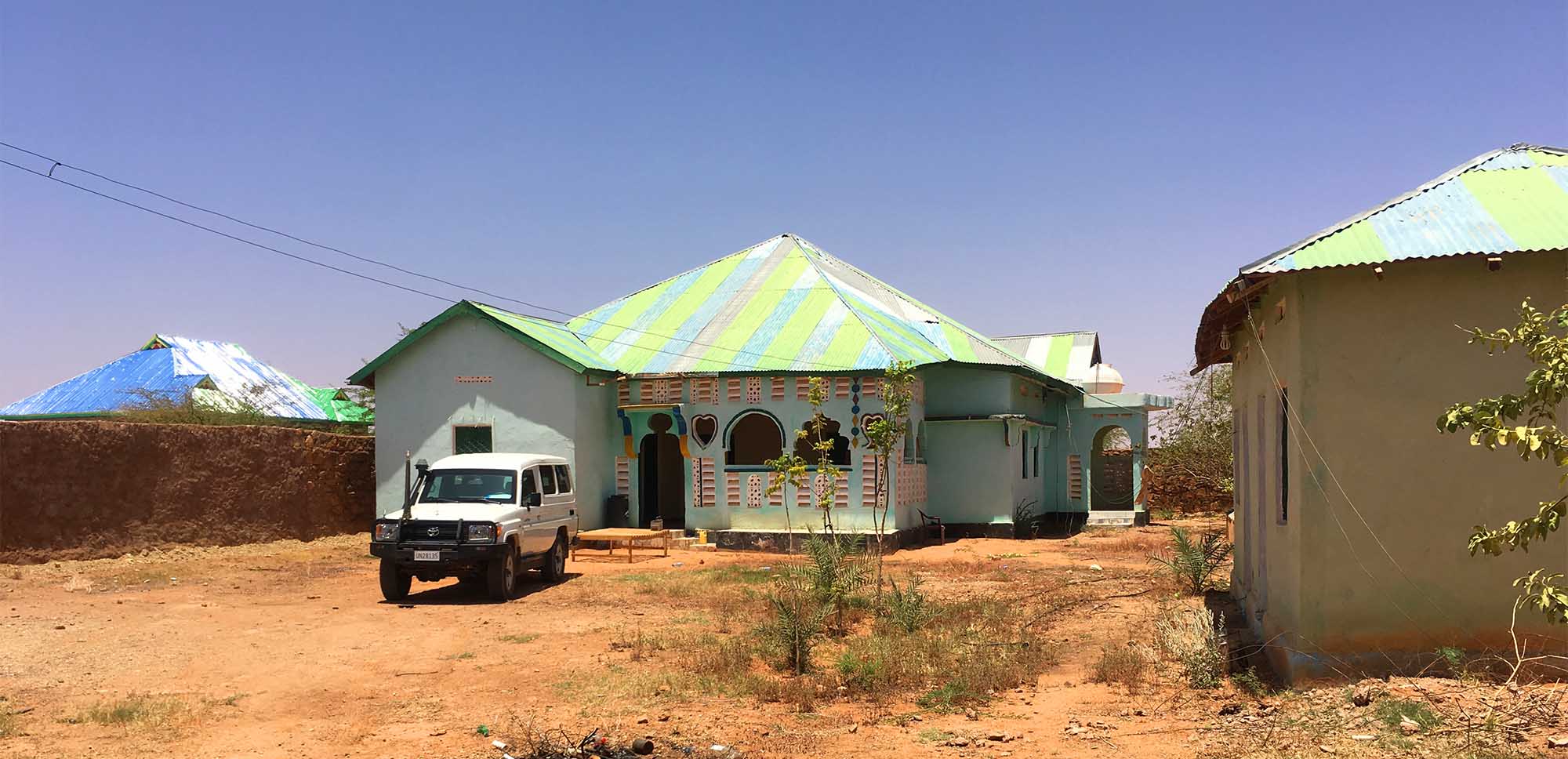

Location: Dolow, Somalia
Type: Sub-office
Organisation: United Nations
Office highlights: Perhaps decorated by the evil twin of whoever designed the Syrian field office below (we’ll never know), this other UN bureau on the Somali-Ethiopian border takes its inspiration from LSD and the rainbow. The colours were fun, but the electricity was off for most of the day and the windows let in a sticky 37ºC breeze in the afternoons.
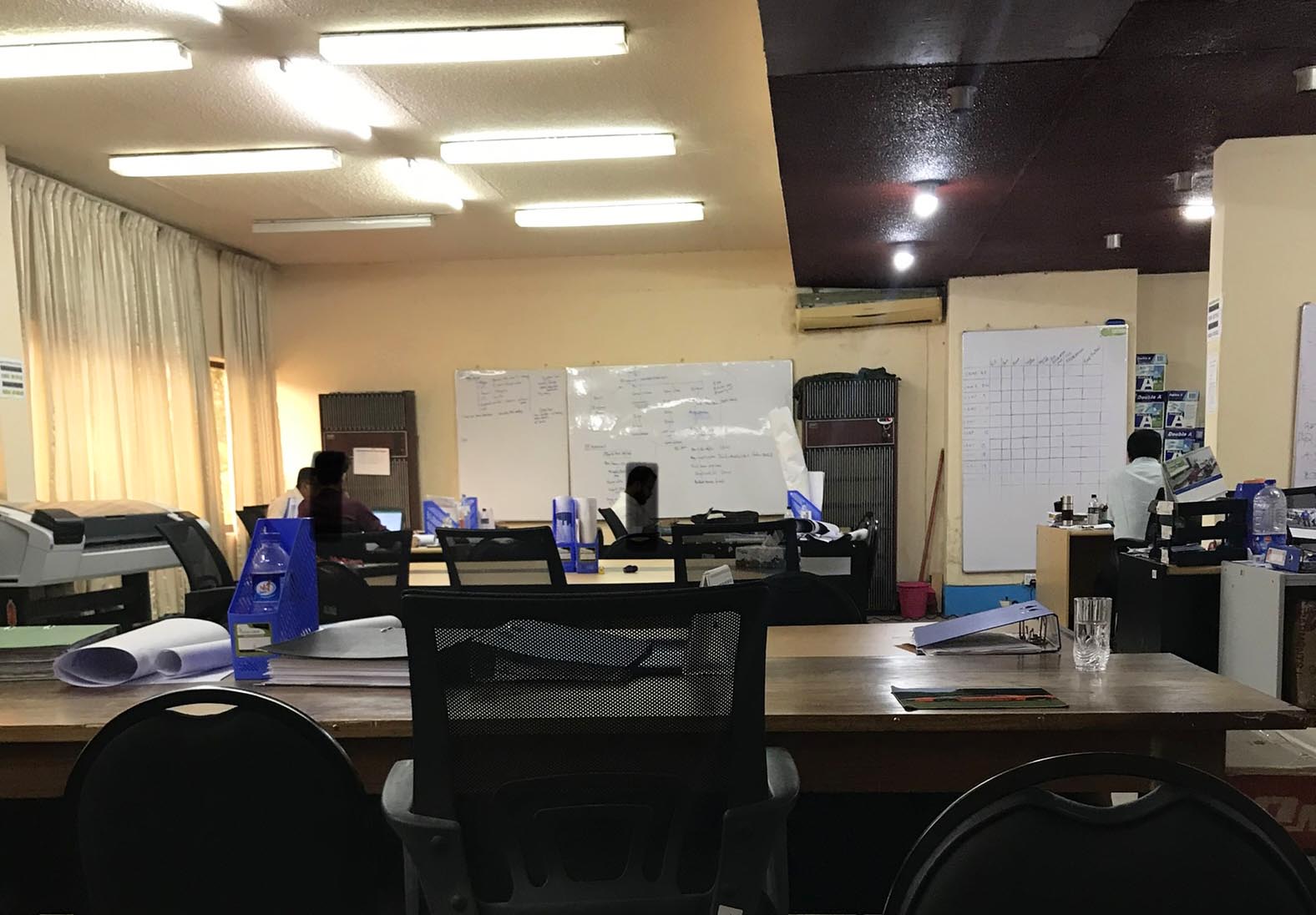
Location: Cox’s Bazar, Bangladesh
Type: Sub-office
Organisation: United Nations
Office highlights: When you imagine working in the largest refugee camp in the world, this dim yellow scene is probably not what springs to mind. But despite its overwhelming array of fluorescent lights, this UN office was filled with fond memories and strong camaraderie. And besides, office time was always brief: usually just a half-hour in the mornings to get organised and discuss urgent issues with colleagues before heading out into the sun, the humidity, and the camps.
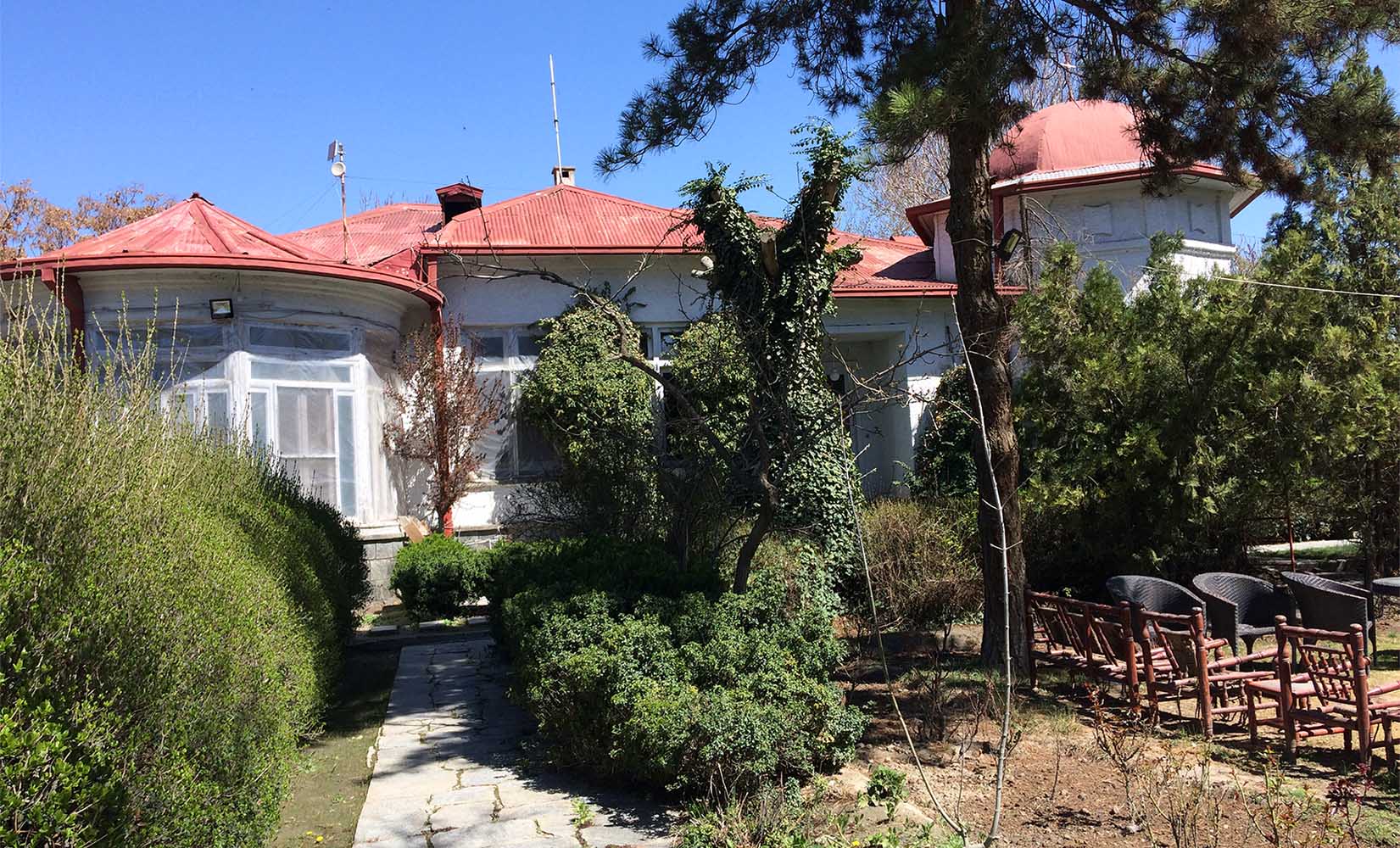
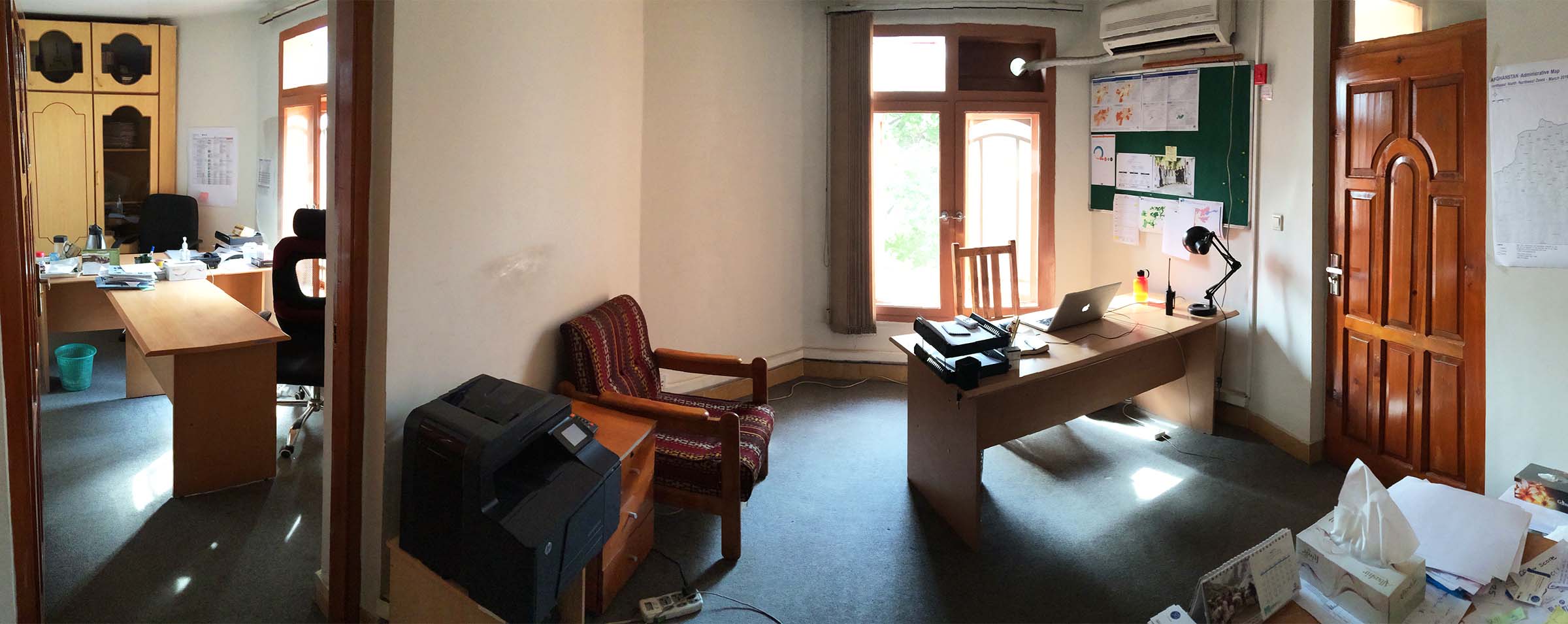
Location: Kabul, Afghanistan
Type: Country office
Organisation: NGO
Office highlights: Originally a grand family home, this NGO office contained both the expat living quarters and the main country office within the same walled compound. The upside was that the morning commute was a 12-second walk across a shaded garden. The downside was that weeks could pass without ever leaving the four walls of the office-cum-guesthouse.

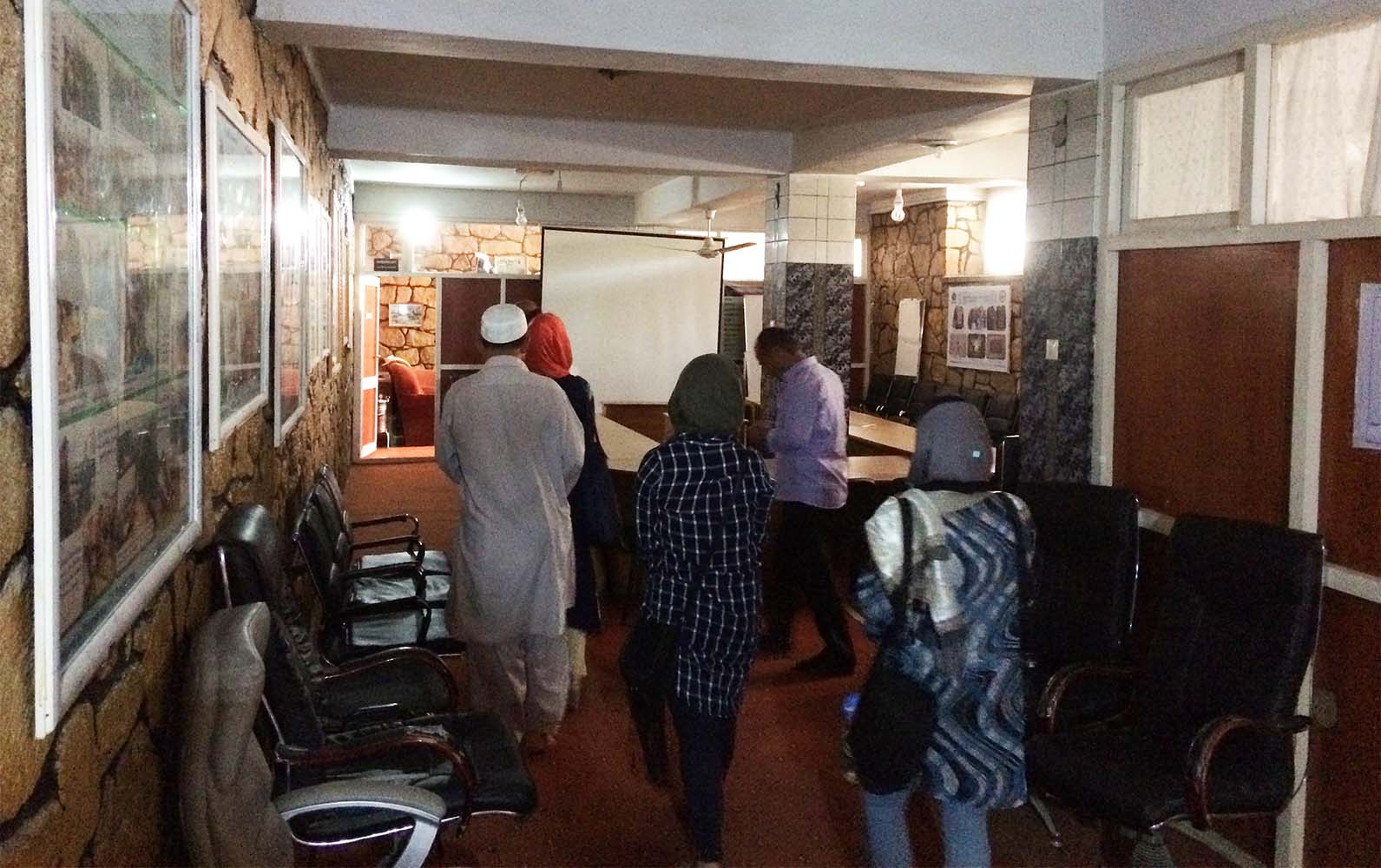
Location: Mazar-i-Sharif, Afghanistan
Type: Sub-office
Organisation: NGO
Office highlights: Not far from the Uzbekistan border lies the fourth largest city in Afghanistan, Mazar-i-Sharif, and this NGO sub-office. A colourful exterior competed with a more miscellaneously-decorated interior. I count four types of office chairs and five types of wall finishings in just this one photo alone.

Location: Northwest Syria
Type: Sub-office
Organisation: NGO
Office highlights: Bold design choices were made in this NGO office: Alice in Wonderland checkered tiles paired with Donald Trump-style gold drapes. But it’s the small details that, for some reason, speak volumes about the vibe of this workplace: the lone fan on the floor, the power strip balanced atop four desks, and the five partially drank cups of tea scattered around the room.
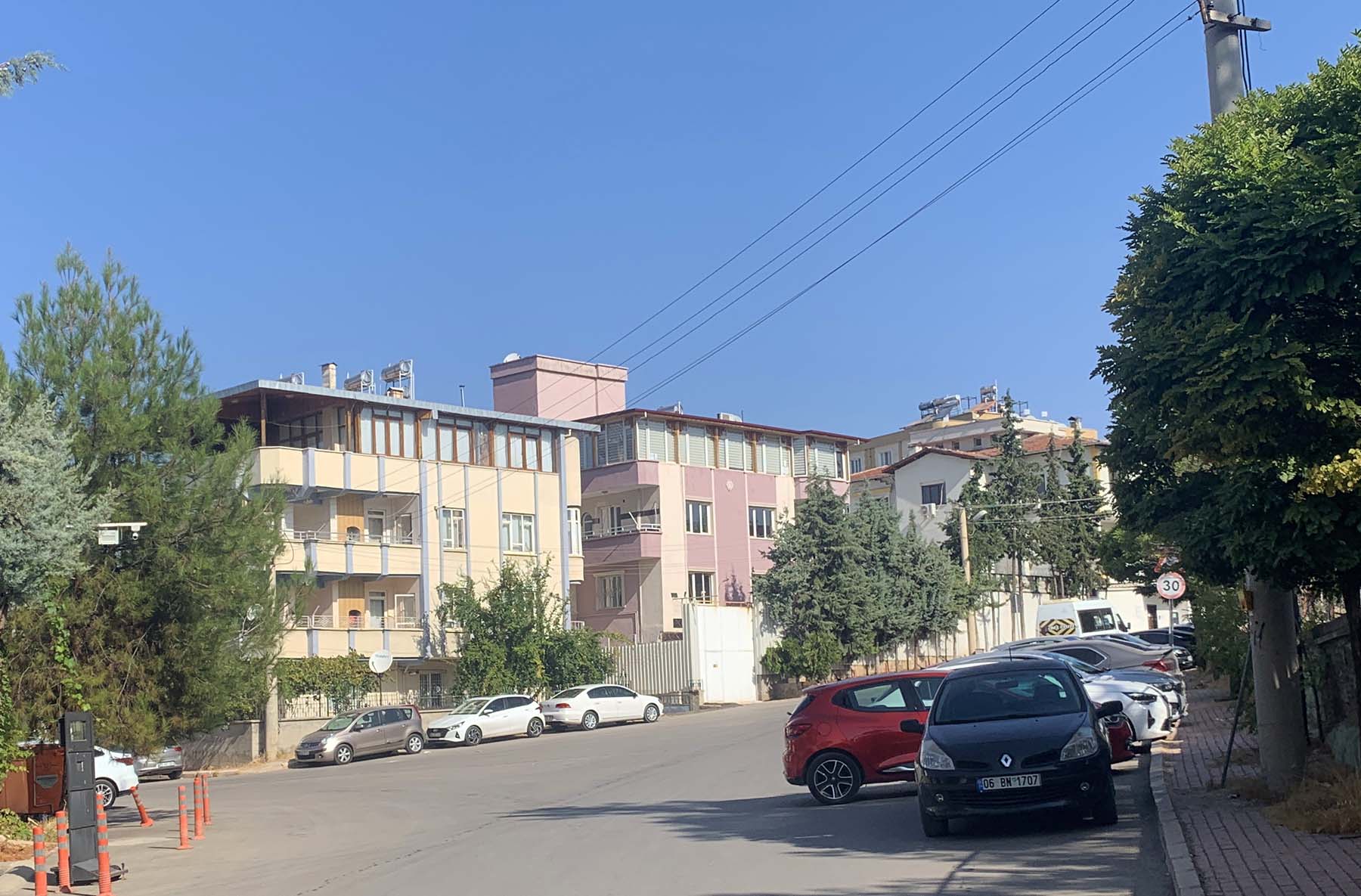
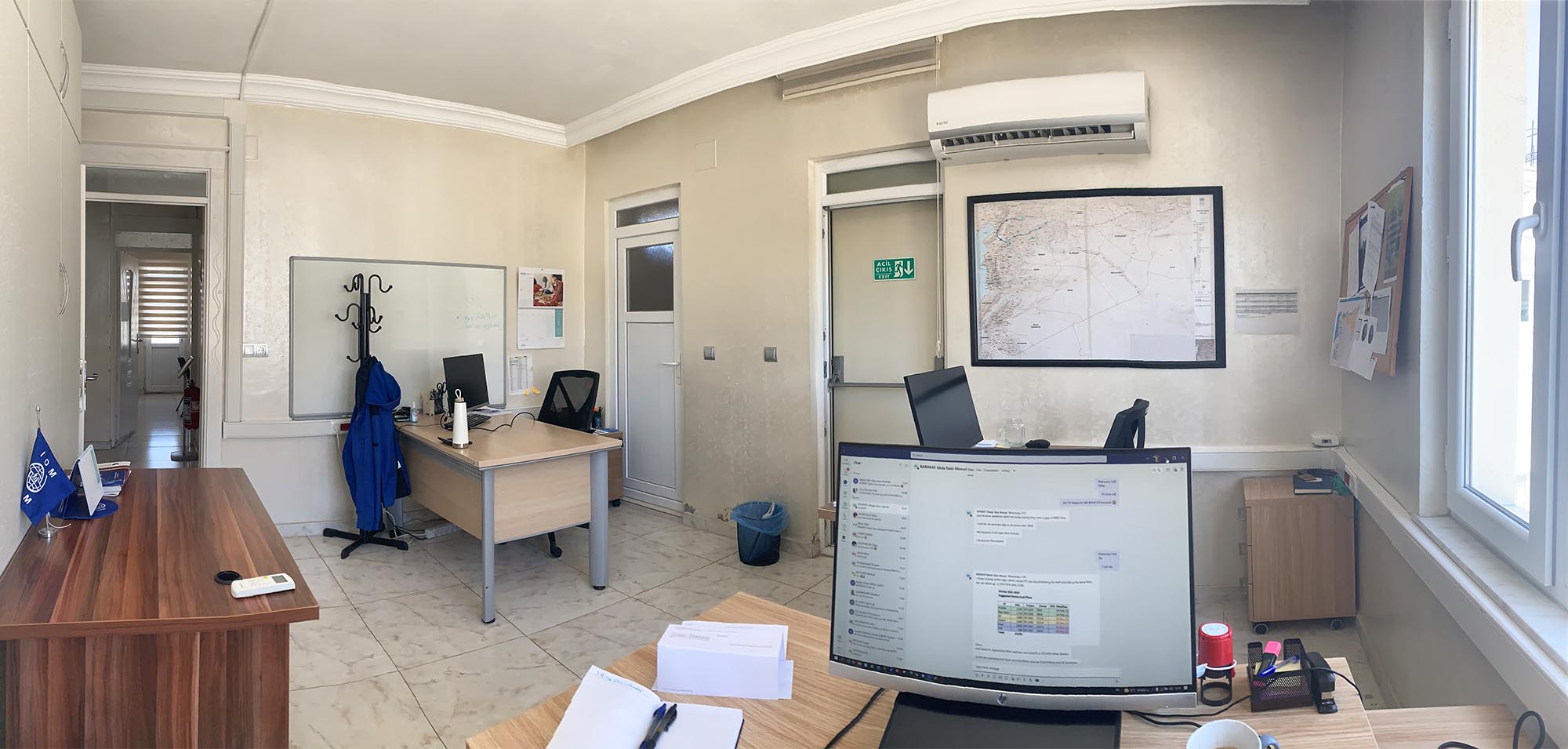
Location: Gaziantep, Türkiye
Type: Sub-office
Organisation: United Nations
Office highlights: One piece of trivia about this UN agency’s sub-office is that it was bigger than the main country office in the capital, Ankara. The second interesting thing is that it was formerly four residential apartment buildings that the organisation rented and converted to offices. The only giveaway from the street was the massive white security gate. This particular office was once a bedroom, and that little door in the corner was once the shower (technically, it still is).
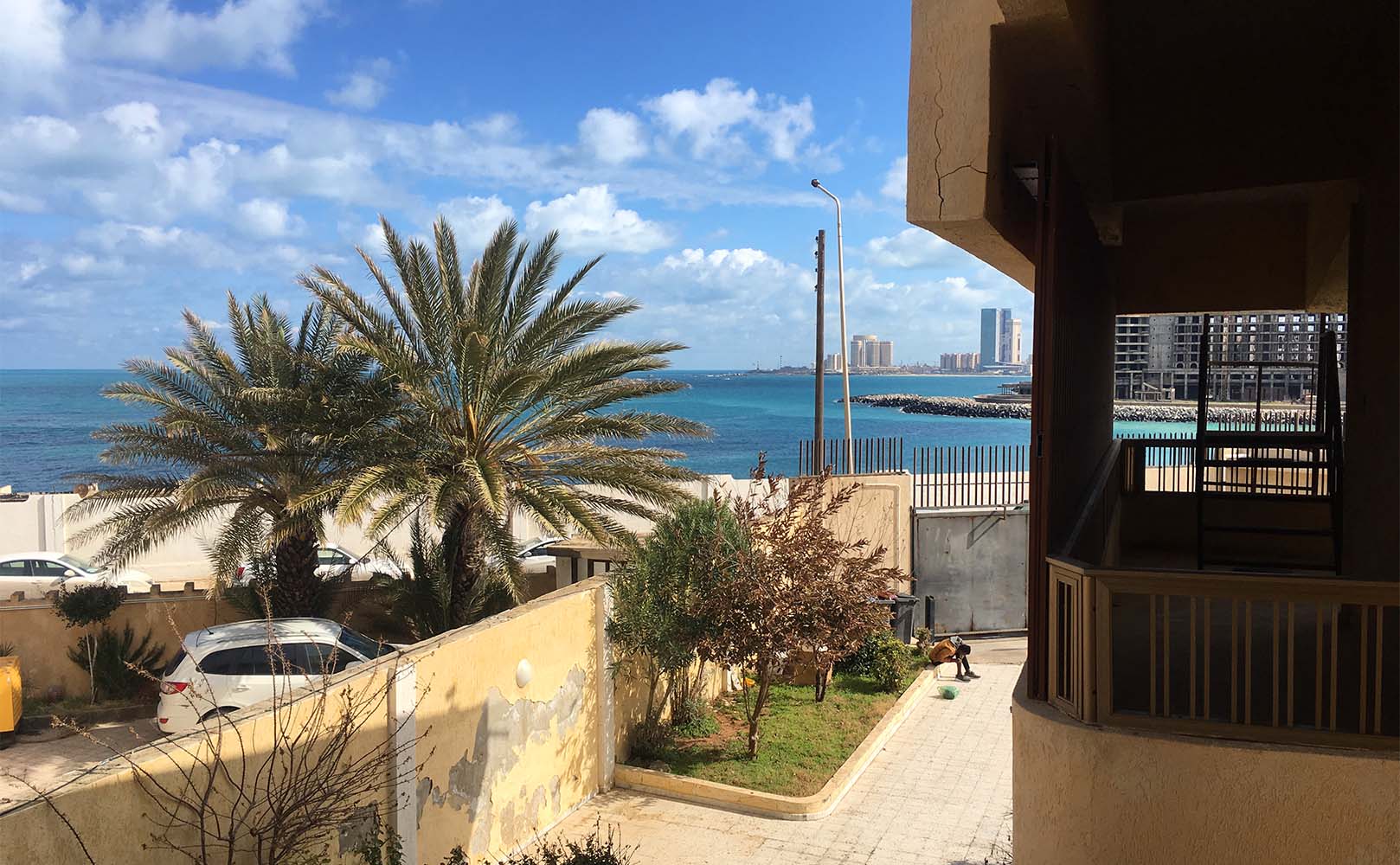


Location: Tripoli, Libya
Type: Sub-office
Organisation: United Nations
Office highlights: This UN agency’s philosophy when searching for a field office in Libya was, apparently: “Let’s rent a gigantic mansion on the seaside which is way bigger than anything we could possibly need, so that all rooms are oversized, mostly empty, and freezing cold in winter.” This avant-garde philosophy was also applied to the staff bathrooms.
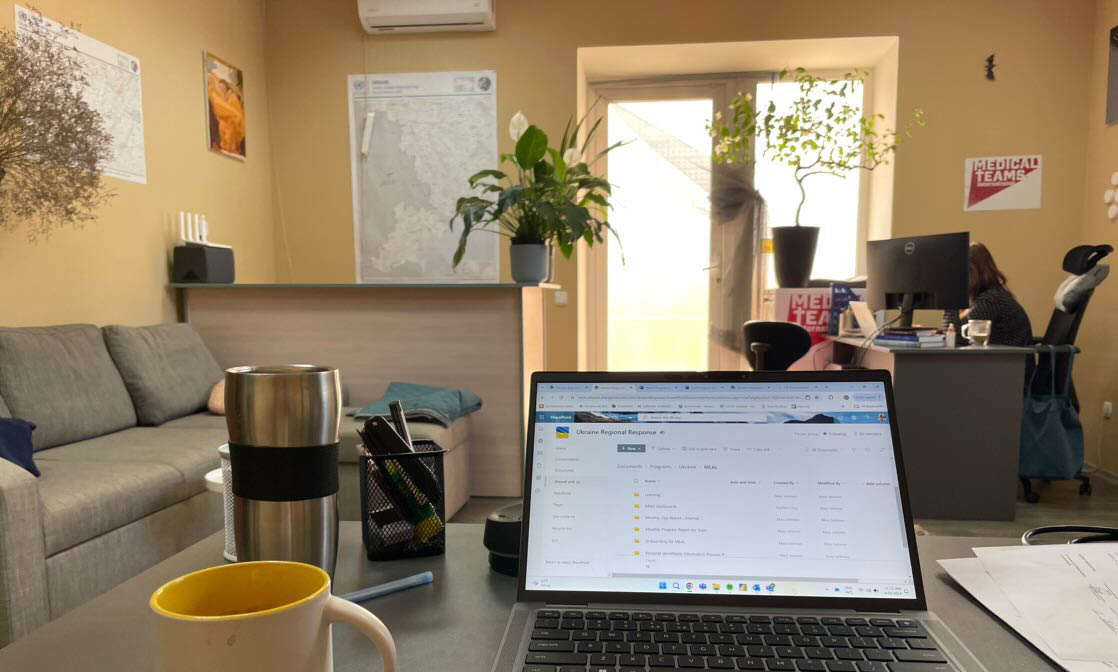
Location: Odessa, Ukraine
Type: Sub-office
Organisation: NGO
Office highlights: Leafy plants and an L-shaped couch make working in this NGO office a remarkably cosy experience. Because it is underground it is also used as a shelter during air strikes, which amplifies the cosy vibes when all staff members are crammed into a few rooms waiting for the sirens to stop.
May 2024
Related posts
From assistants and officers to managers and coordinators, we crack the code of humanitarian job titles and where they rank in the organigramme.
Don’t bother with the United Nations. Aim for NGOs that you’ve never heard of before.
Hiring managers from across the aid industry give their advice on what makes a great CV and cover letter. However, they don’t always agree.
The sheer number of aid organisations can be overwhelming. So we made a list. This is the definitive roll call of every major international humanitarian NGO.
The veteran Camp Manager explains why the job is among the most challenging in the industry. And why, after nine years, it’s also her favourite.
From medical assistance and food distribution to logistics and finance, your humanitarian career is shaped by your technical specialisation.
Weeklong rest-and-relaxation holidays are a common feature of humanitarian contracts. Is it the best job perk ever or the framework for a lonely lifestyle?
The Syria-based Protection specialist reflects on the power dynamics of aid and the privileged position that humanitarians often have in fragile countries.
Growing up in rural Sweden, the Red Cross delegate never aimed to be an aid worker. Now, at 33, he has built a career working with communities amid crisis and conflict.

